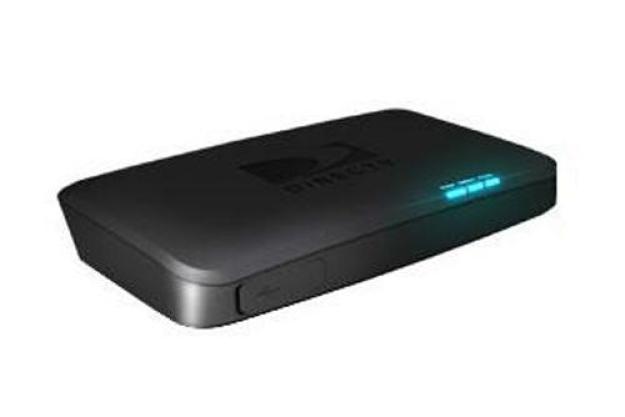
“You can’t transfer a one-hour program to your client device until at least two hours after it has aired.”
- Transfers premium TV programming to portable devices
- Supports PC, Mac, iPhone, and iPod touch
- Automatic transcoding
- No monthly fee
- Doesn’t support Android and iPad
- DVR-to-Nomad transfers occur in real time
- Can’t transfer pay-per-view or on-demand recordings
- Must be hard-wired to your network
Proselytizers of the cable-cutter movement claim there are plenty of ways to get TV entertainment for free, without having to pay cable and satellite TV service providers a red cent. While I don’t consider myself a contrarian, I don’t think that’s entirely realistic—or even fair. I don’t work for free, and I don’t expect anyone else to, either. So I don’t mind paying the piper—DirecTV in my case, because I live in a rural area not serviced by cable TV—for premium TV in high definition.
I wouldn’t complain if I was asked to pay less, of course, but what really curls my short hairs is that I pay for a lot of TV I never get to watch because I’m away from home so much. That’s why I paid $149 for DirecTV’s Nomad soon after the product quietly hit the market late in 2011: The promises DirecTV made for the Nomad made it sound as though the device would fit my needs perfectly. It comes pretty close, but it has enough annoying limitations that it earns only a highly qualified recommendation.
The promise
The Nomad, which is about the size of a paperback book, connects to your wireless router on the same network as your DirecTV DVR (both must devices must be hardwired to the network). You must have either a DirecTV Plus HD DVR (model HR20 or later) or a DirecTV Plus DVR (model R22). Any TV program you record on your DVR can then be copied over your network and temporarily stored on the Nomad’s 16GB of flash memory. Transfer those programs over your network to your PC, Mac, iPhone, or iPod touch, and you can watch them on that device (you’re limited to any combination of five clients).

DirecTV has promised iPad and Android support for the Nomad ever since the device shipped, but neither were available as of this writing. You can, of course, run the iPhone app on the iPad, but the user interface and the playback window are designed for the smaller screens on those devices. While you can zoom the UI and playback window by 2x on the iPad, the resolution leaves much to be desired.
The reality
The Nomad isn’t a DVR, so you can’t record programs directly to it; you must record the programs on your DVR and then transfer them from the DVR to the Nomad. So you can’t initiate the transfer of a one-hour program to the Nomad until at least one hour after the program has aired. And since these transfers occur in real time, a one-hour program takes one hour to be transferred from the DVR to the Nomad. That means you can’t transfer a one-hour program to your client device until at least two hours after it has aired.
The software running on the client shows all the programs available on your DVR that can be transferred. You can flag TV series to automatically transfer every recorded episode, but you can’t do this for movies or other programming. And you must use one of the supported client devices to set that flag, because you can’t control the Nomad from the same user interface you use to manage the DVR. On the bright side, transferring a program from the Nomad to a client device takes place at network speed. On the other hand, you must be on your own network to perform these transfers—you can’t do it over the Internet. That’s a drag if you’re away from home as much as I am.

Another limitation is that you can’t transfer recordings of any pay-per-view content, nor can you transfer recordings of on-demand content—even if it’s the same programming that you could have recorded at whatever time and date DirecTV offered it on its schedule. And programs that can be transferred expire after 30 days, whether you’ve watched them or not.
You might argue that Dish Network’s Slingbox is a far superior remote-viewing solution, because it can stream any content from a Dish DVR—live or recorded—to a remote client over the Internet. But the Slingbox depends on a fast Internet access at both ends, and the quality of your experience is heavily dependent on a fast upstream connection at the DVR end. If you live in a rural area — as most satellite TV subscribers do — you’re likely dependent on DSL or a service with an even slower uplink. Once you’ve transferred a program to the client running the Nomad software, you can watch it anywhere—even if you don’t have Internet access.
Conclusion
Most of the Nomad’s limitations are likely the result of DRM (digital rights management) restrictions, but there’s just no excusing the glacial pace the company is taking to add support for the iPad and the Android platform. The same goes for the failure to support HDMI out through the iPad’s docking port. Still, this is one of the only solutions we’ve seen for taking premium TV content on the go, and it’s certainly the easiest to use.
Highs
- Transfers premium TV programming to portable devices
- Supports PC, Mac, iPhone, and iPod touch
- Automatic transcoding
- No monthly fee
Lows
- Doesn’t support Android and iPad
- DVR-to-Nomad transfers occur in real time
- Can’t transfer pay-per-view or on-demand recordings
- Must be hard-wired to your network
Editors' Recommendations
- Comcast says accessibility is no longer an afterthought
- A DirecTV satellite could explode in space because of a battery issue


